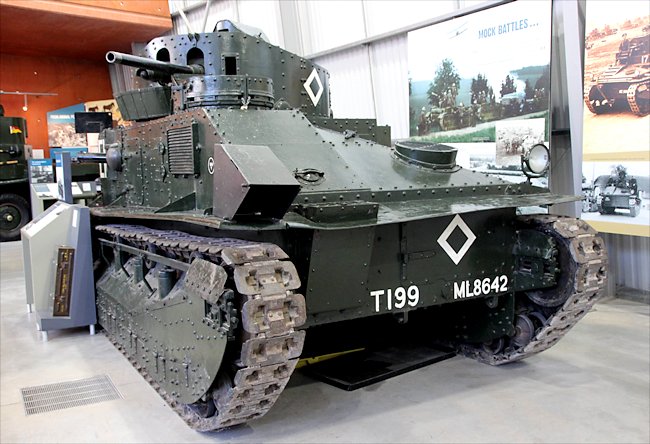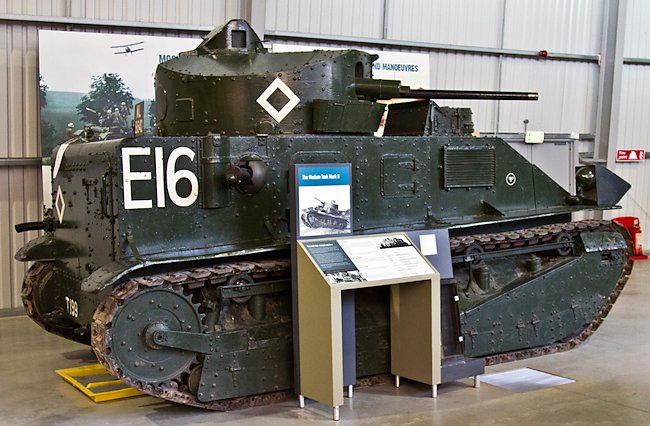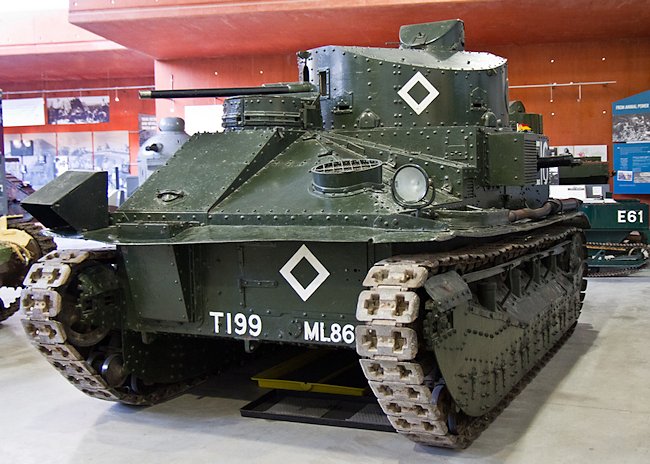Vickers Medium MkII tank
This preserved 1920s British Vickers Medium MkII tank can be found at the Tank Museum, Bovington, England. It was used as a training tank at Bovington in the early years of the Second World War. Vickers and the Royal Ordnance Factory built about 160 Vickers Mediums for the British Army between 1923 and 1928. The Tank Museum’s example is a Mark II*, one of 13 built under a contract issued in January 1926.

Surviving Vickers Medium MkII tank at the Tank Museum, Bovington, England.
Location
This Vicker's Medium MkII Tank is on show at the Tank Museum, Linsay Road, Bovington, Dorset. The nearest train station is Wool Railway Station. You can walk the 2 miles to the Museum but there are not pavements along the country road and if you are travelling with children it can be dangerous. It takes 45 minutes by foot. There is an irregular bus service from Wool Station that will get you to the museum but they only come once an hour in the morning starting after 9.30.
The last bus back to the station from the Tank Museum is just after 13.45 which is really silly. There is no Sunday bus service. The easiest way to get to the museum from the train station is by taxi. They can be pre booked with Garrison Cars to meet you when your train arrives and pick you up for the return trip from outside the museum. Their phone number is 01929 463395
Specifications
The Vickers Medium tank weighed 11.7 tons and was powered by an Armstrong Siddeley V-8 petrol engine that produced 90 hp. The tank had a top road speed of 15mph (24 km/h) which may seem extremely slow by today's standards but it was 3x faster than to top speed of the heavy tanks of WW1 and matched the speed of the WW1 Whippet 'light' tank. It was technologically advanced in other more important ways. It had a top mounted gun turret that could travers 360°s.
The five man crew were protected by armour plating that ranged in thickness from 4 mm to 6.25 mm. It had an operational range of around 120 miles (190 km) before it needed to refuel which was over double the range of the WW1 tanks. It was armed with a 3 pounder quick firing (QF 3pdr 47mm) gun. It was also armed with two 0.303 Vickers machine guns (7.7mm) and four 0.303 French Hotchkiss model 1914 machine guns.

Surviving Vickers Medium MkII tank at the Tank Museum, Bovington, England
Production and design
The Vickers Armstrong Medium Tanks were the core of the Royal Tank Corps from 1923 until 1938. Introduced in 1923 the Vickers Mediums were the first British tanks to see service fitted with a sprung suspension and a rotating turret. Designed to fight on the move, their high speed of 30 mph restored mobility to the battlefield. The hull was riveted. The engine, an air cooled Armstrong Siddeley, was mounted in the front of the tank, alongside the driver. Originally described as a light tank, the advent of even smaller tanks weighing about five tons, resulted in the Vickers’ design being reclassified as a medium tank.
The first version, the Medium Mark I, had a 3pdr (47mm) gun in the turret, a Vickers machine gun in each side of the hull and Hotchkiss light machine guns in the turret. The 3pdr gun fired an armour piercing high explosive projectile (APHE) that weighed 3 pounds 4 ounces at 1,840 feet/second. It could penetrate 1 inch (25mm) of homogenous steel armour at 1,000 yards and had a maximum range of 2,000 yards. This was more than adequate to fight contemporary tanks but was useless against field fortifications and anti-tank guns. These were supposed to be dealt with by a close support version, armed with a 3inch mortar fitted in the turret.
In addition to the gun tanks there were also command post and bridge laying versions. The tracks used on these early tanks had a short life. Vickers built an experimental vehicle in 1926, based on the Medium Mark I that had both wheels and tracks. The wheels were to be used when travelling on roads; unfortunately the vehicle proved to be dangerously unstable.
Vickers Mediums formed the backbone of the British Army’s Experimental Mechanised Force of 1928. This was a revolutionary combat formation that carried out manoeuvres on Salisbury Plain. Unfortunately economic recession and the conservatism of the General Staff stifled the revolution.
The Medium Mark II was completely obsolete by the beginning of World War II. The survivors were used for training during the first few years of the War. Some were issued to combat forces to make up their strength after the loss of most British first line tanks during the retreat from France in 1940. Others were sent to Egypt as training vehicles and were pressed into service with the Western Desert Force. They were buried as fixed defences at Mersa Matruh and Tobruk.
Vickers sold 15 Medium Tanks to the Soviet Union in 1930. Not adopted for production, they were used for training and were known as the ‘English Workman’ tanks. Rather surprisingly, the Finns captured half a dozen of these relics from the Russians in the autumn of 1941. At least one other went to Australia, while a single example of a developed version, the Mark C, was sold to Japan. This vehicle formed the basis of the Japanese Type 89 tank design. A single example of the final version, the Medium Mark D, was sold to Eire where it remained in service until 1940.

Surviving Vickers Medium MkII tank at the Tank Museum, Bovington, England
Vickers Medium Tank variants?
- The Mark I was succeeded by a series of improved models.
- The Mark IA had the maximum armour thickness increased from 6mm to 8mm, a redesigned driver’s hatch and an anti-aircraft mounting for an additional Hotchkiss machine gun.
- The Mark IA* was fitted with a commander’s cupola; the Hotchkiss machine guns were all replaced by a single Vickers machine gun mounted co-axially with the 3pdr main gun.
- The Mark I (Indian Pattern) was only armed with machine guns.
- The Mark II, introduced in 1925 was similar to the Mark I; armoured skirting plates protected the tracks.
- The Mark II* dispensed with the Hotchkiss machine guns and had a co-axial Vickers machine gun instead.
- The Mark II**, converted from Mark II* tanks, had separate mountings for the 3pdr and a 0.303 inch Vickers machine gun; an armoured container for a radio was fitted to the rear of the turret.
- The Mark IIA had the ventilator, fitted to the left side of the tank, covered by an armoured box.
Medium MkII tanks in London
Tanks took to the streets of London as part of the British Government’s response to the General Strike (4th – 13th May 1926). The strike was called to protest pay reductions and worsening conditions for 1.2 million coal miners. Around 1.7 million other workers took part, mainly those employed in transportation, printing and iron and steelworking. Several thousand volunteers came forward to try and maintain essential services, such as food deliveries. The government deployed unarmed soldiers and volunteer Special Constables to help protect them and to assist the Police. As part of this effort the 3rd Battalion Royal Tank Corps deployed two Companies of Peerless Armoured Cars and one Company of Vickers Medium Mark II Tanks to London.
Where can I find other preserved Vickers Medium Tanks?
- MkI - Special Services Battalion Museum, Bloemfontein, South Africa
- MkII - Bovington Tank Museum (UK) – running condition
- MkII - Royal Australian Armoured Corps Tank Museum, Puckapunyal, VIC, Australia
- MkIIA - U.S. Army Center for Military History Storage Facility Anniston, AL, USA
- Source - Pierre-Oliver Buan - http://the.shadock.free.fr/Surviving_Panzers.html
World War Two books

